Have you ever wondered how some of the most intricate and durable 3D-printed objects are made? The secret often lies in a remarkable technology known as Selective Laser Sintering (SLS). Whether you’re a curious newcomer or a seasoned professional in the world of 3D printing, understanding SLS can unlock a whole new realm of possibilities for your projects.
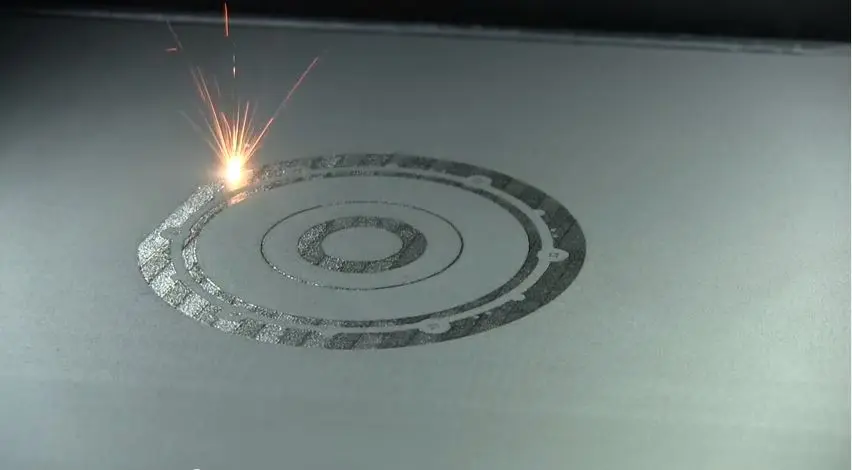
Imagine being able to print complex shapes and designs without the hassle of support structures or extensive post-processing. SLS 3D printing makes this possible, offering incredible flexibility, efficiency, and high-quality results. But how does it work? What materials can you use? And how does it stack up against other 3D printing methods like Multi Jet Fusion (MJF) or Fused Deposition Modeling (FDM)?
In this article, we will answer all these questions and more. We’ll start by explaining what SLS is and how it operates. Next, we’ll compare it with other popular 3D printing technologies to help you understand its unique advantages and limitations. We’ll also dive into the various materials you can use with SLS, and discuss the pros and cons of this fascinating technology. To wrap things up, we’ll provide some tips on design considerations and post-processing options to help you achieve the best results with your SLS projects.
So, if you’re ready to dive into the world of SLS 3D printing and discover how it can revolutionize the way you create, keep reading. This guide will serve as your complete resource for understanding and utilizing SLS technology to its fullest potential.
What is Selective Laser Sintering (SLS)?
Selective Laser Sintering (SLS) is a groundbreaking 3D printing technology that has gained immense popularity for its ability to produce highly detailed and durable parts. But what exactly is SLS, and why is it so revolutionary?
Understanding Selective Laser Sintering
At its core, SLS is an additive manufacturing process that uses a high-powered laser to fuse small particles of powdered material into a solid structure. The powder bed is selectively sintered, layer by layer, to create a three-dimensional object. This method is particularly advantageous for producing complex geometries that would be difficult or impossible to achieve with traditional manufacturing techniques.
How Does SLS Work?
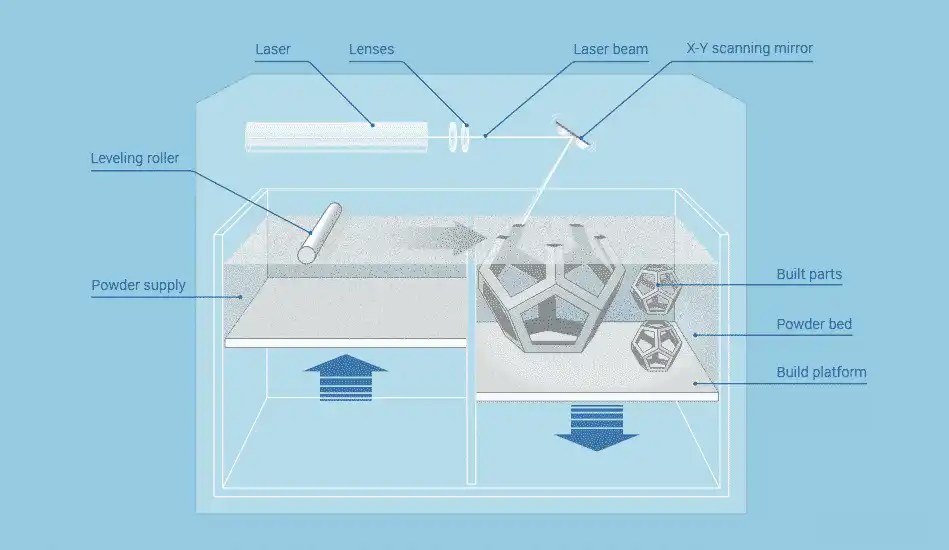
The SLS process involves several key steps:
- Preparation: The first step involves spreading a thin layer of powdered material across the build platform. The material can be a variety of thermoplastics, metals, or ceramics.
- Scanning: A high-powered laser then scans the surface of the powder bed, following the digital design of the part. The laser selectively fuses the powdered particles, solidifying them.
- Layering: Once a layer is complete, the build platform lowers, and a new layer of powder is spread over the surface. The process repeats until the entire object is formed.
- Cooling and Unpacking: After the printing process is complete, the build chamber is allowed to cool. The parts are then carefully removed from the powder bed and any excess powder is brushed away.
Key Benefits of SLS
SLS offers several advantages that make it a preferred choice for many applications:
- Complex Geometries: SLS can produce intricate designs without the need for support structures.
- Material Versatility: A wide range of materials, including Nylon, TPU, and other thermoplastics, can be used.
- High Strength and Durability: Parts produced using SLS exhibit excellent mechanical properties.
- Efficiency: The process is highly efficient, with minimal material waste.
Applications of SLS
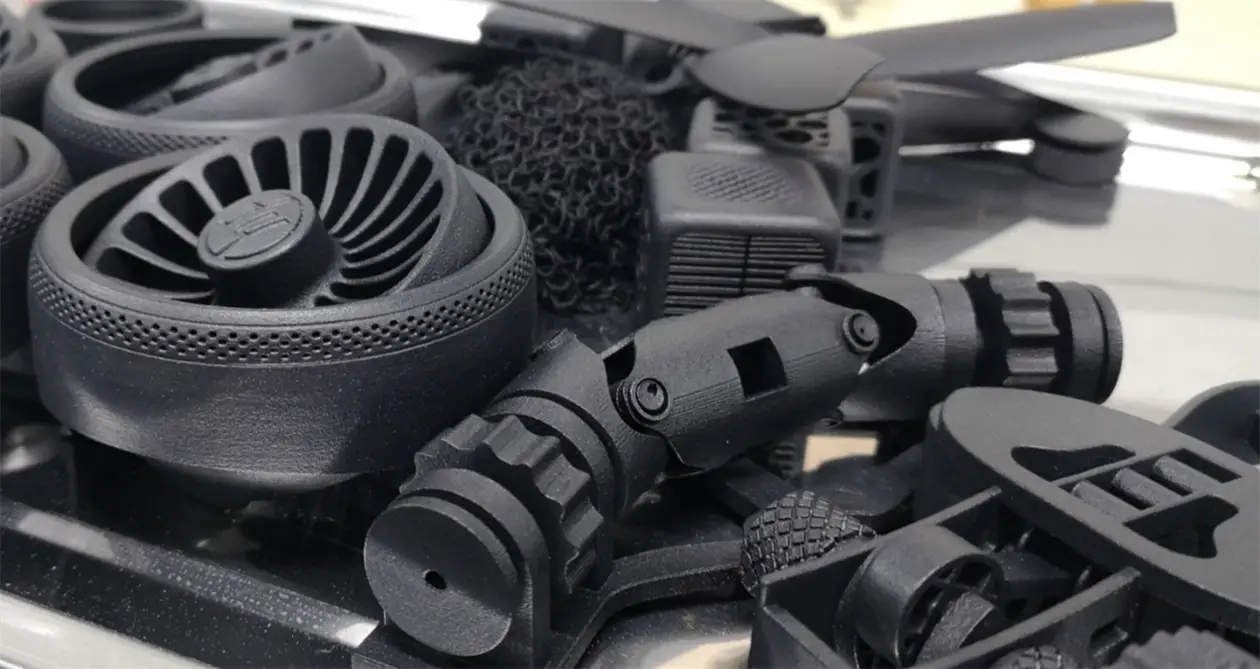
SLS is used in various industries, including:
- Aerospace: For lightweight, strong components.
- Automotive: For prototype parts and custom components.
- Medical: For custom prosthetics and surgical guides.
- Consumer Goods: For custom and small-batch production items.
SLS vs. Other 3D Printing Technologies
| Feature | SLS | FDM | MJF |
| Material Versatility | High | Medium | High |
| Surface Finish | Rough | Smooth | Smooth |
| Part Strength | High | Medium | High |
| Complexity | High (no supports needed) | Medium (supports needed) | High (no supports needed) |
| Cost | Medium to High | Low | Medium to High |
Selective Laser Sintering (SLS) is a powerful 3D printing technology that offers unparalleled flexibility, efficiency, and quality. By understanding how SLS works and its key benefits, you can better appreciate why it has become such a popular choice in various industries. Whether you’re looking to produce complex geometries, utilize a wide range of materials, or achieve high-strength and durable parts, SLS provides a versatile and efficient solution.
How Does SLS 3D Printing Work?
Selective Laser Sintering (SLS) is a fascinating 3D printing process that combines precision, efficiency, and versatility. To truly appreciate the capabilities of SLS, it’s essential to understand how this technology operates from start to finish. In this article, we’ll break down the SLS process, explore the key components of an SLS printer, and highlight the factors that contribute to its effectiveness.
The SLS Process Explained
The SLS process can be divided into several distinct stages, each playing a crucial role in creating a high-quality final product. Here’s a detailed look at each step:
- Preparation:
- CAD Design: The process begins with a Computer-Aided Design (CAD) model of the object to be printed. This digital file is then converted into a format that the SLS printer can interpret, typically an STL file.
- Material Loading: The chosen powder material (such as Nylon, TPU, or another thermoplastic) is loaded into the printer’s powder bed.
- Layering:
- Powder Spreading: A thin layer of powder, typically around 0.1 mm thick, is spread evenly across the build platform using a roller or blade.
- Laser Sintering: A high-powered laser scans the powder layer based on the cross-sectional data from the CAD model. The laser selectively fuses the powder particles, solidifying them to form the first layer of the object.
- Repetition:
- Platform Lowering: Once a layer is completed, the build platform lowers by the thickness of one layer.
- New Layer Application: A new layer of powder is spread over the surface, and the laser sinters the next layer of the object. This process repeats until the entire object is built.
- Cooling and Finishing:
- Cooling: After the printing is complete, the build chamber is allowed to cool down gradually to prevent thermal stress and warping.
- Unpacking: The printed parts are carefully removed from the powder bed, and any excess powder is brushed away or recycled for future use.
Key Components of an SLS Printer
An SLS printer consists of several critical components that work together to ensure precise and efficient printing. Here are the main elements:
- Laser Source: The heart of the SLS printer, this high-powered laser selectively sinters the powder particles.
- Optical System: This includes mirrors and lenses that direct and focus the laser beam onto the powder bed.
- Build Platform: The surface on which the object is built, capable of lowering incrementally to accommodate new layers of powder.
- Powder Supply and Recoating System: This system spreads a new layer of powder over the build platform after each layer is sintered.
- Control System: The software and hardware that manage the entire printing process, ensuring accuracy and precision.
Advantages of SLS Printing
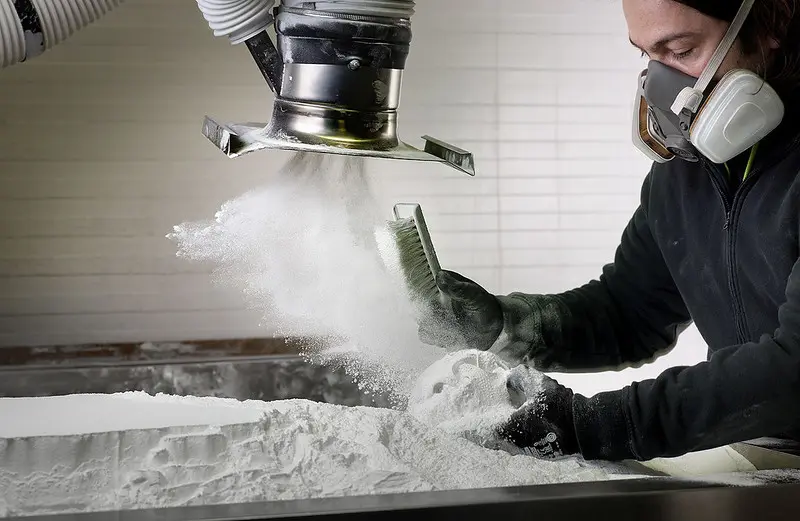
SLS 3D printing offers several notable advantages, making it a popular choice for a wide range of applications:
- Complex Geometries: SLS can produce intricate designs without the need for support structures, allowing for greater design freedom.
- Material Efficiency: The unused powder can be recycled, reducing material waste and lowering costs.
- High-Quality Parts: SLS parts exhibit excellent mechanical properties, including high strength and durability.
- Scalability: SLS is suitable for both prototyping and large-scale production, offering flexibility for various manufacturing needs.
SLS Process Overview
| Stage | Description |
| Preparation | CAD design, material loading |
| Layering | Powder spreading, laser sintering |
| Repetition | Platform lowering, new layer application |
| Cooling | Gradual cooling to prevent thermal stress |
| Finishing | Unpacking, removal of excess powder |
Understanding how SLS 3D printing works is key to unlocking its full potential. From the initial preparation and layering to the final cooling and finishing, each step is meticulously designed to produce high-quality, intricate parts. With its ability to handle complex geometries, recycle materials, and deliver strong, durable products, SLS stands out as a versatile and efficient 3D printing technology.
Whether you’re a manufacturer looking to streamline production or a designer aiming to push the boundaries of creativity, SLS 3D printing offers a powerful solution. By mastering the SLS process and leveraging its unique advantages, you can transform your ideas into reality with precision and efficiency.
SLS vs. Other 3D Printing Technologies
Selective Laser Sintering (SLS) is a standout among 3D printing technologies, but how does it compare to other popular methods like Multi Jet Fusion (MJF) and Fused Deposition Modeling (FDM)? Understanding these differences can help you choose the best technology for your specific needs. In this article, we’ll dive deep into the comparisons, highlighting the strengths and weaknesses of each technology.
Comparison with Multi Jet Fusion (MJF)
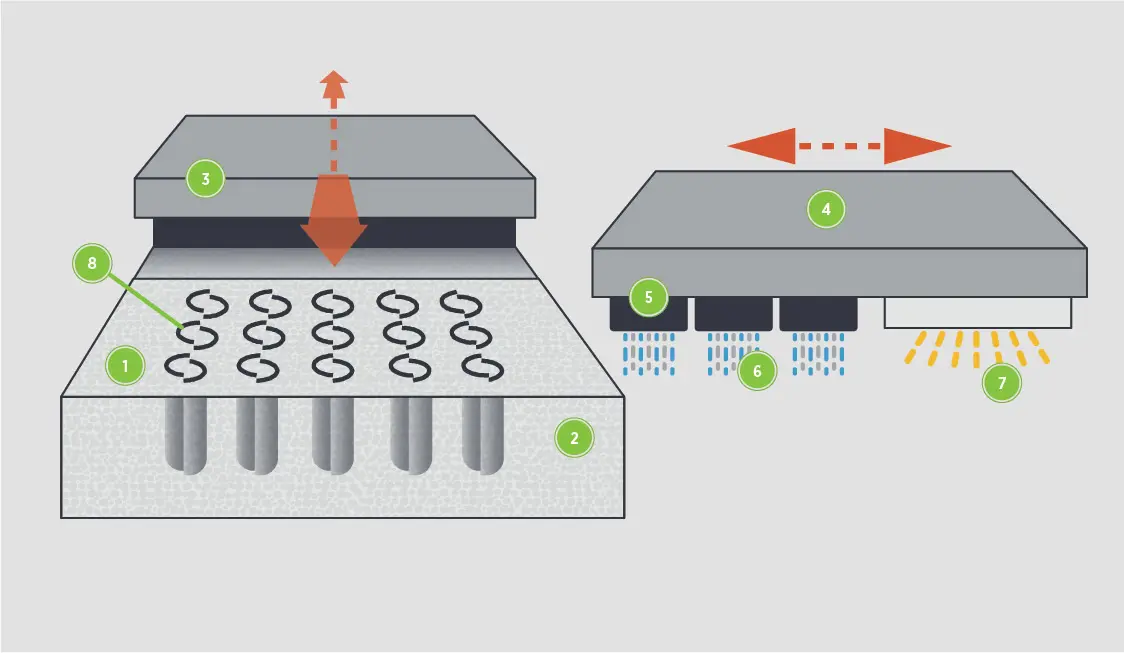
Multi Jet Fusion (MJF) is another advanced 3D printing technology that shares some similarities with SLS but also has distinct differences. Let’s break down the comparison:
How MJF Works:
- Binder Jetting: MJF uses a binding agent that is selectively jetted onto a powder bed. This agent helps to fuse the powder particles together.
- Thermal Fusion: Infrared lamps pass over the powder bed to fuse the particles in the areas where the binding agent has been applied.
Key Differences from SLS:
- Speed: MJF is generally faster than SLS because it can process multiple layers simultaneously.
- Surface Finish: MJF parts often have a smoother surface finish compared to SLS, which can require additional post-processing to achieve similar results.
- Material Properties: Both technologies can produce parts with excellent mechanical properties, but MJF parts are typically more isotropic, meaning they have uniform strength in all directions.
Advantages of MJF:
- Faster Production: Ideal for high-volume production runs.
- Smoother Surface Finish: Reduced need for post-processing.
- Uniform Mechanical Properties: Consistent strength in all directions.
Disadvantages of MJF:
- Material Limitations: Fewer material options compared to SLS.
- Higher Initial Costs: MJF machines and materials can be more expensive.
Differences from Fused Deposition Modeling (FDM)
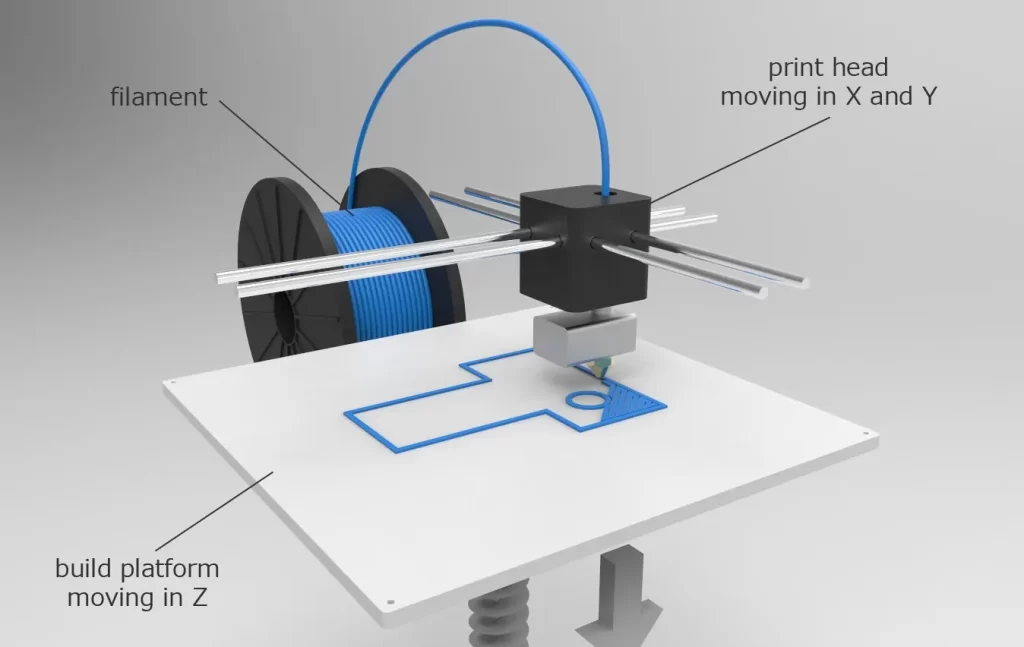
Fused Deposition Modeling (FDM) is one of the most widely used 3D printing technologies, especially for hobbyists and desktop printers. Here’s how it stacks up against SLS:
How FDM Works:
- Extrusion: FDM uses a heated nozzle to extrude thermoplastic filament layer by layer to build an object.
- Support Structures: FDM often requires support structures to print complex geometries, which are removed after printing.
Key Differences from SLS:
- Support Structures: SLS does not require support structures, whereas FDM does, making SLS better suited for complex designs.
- Surface Finish: FDM parts often have visible layer lines and may require significant post-processing to achieve a smooth surface.
- Material Properties: FDM parts generally have lower mechanical properties compared to SLS parts, making them less suitable for functional prototypes or end-use applications.
Advantages of FDM:
- Low Cost: FDM printers and materials are typically less expensive.
- Ease of Use: User-friendly and accessible for beginners.
- Material Variety: Wide range of filament materials available.
Disadvantages of FDM:
- Lower Strength: Parts are generally weaker compared to SLS and MJF.
- Support Structures Needed: Additional post-processing required to remove supports.
- Surface Finish: Often requires sanding or other finishing techniques.
SLS vs. MJF vs. FDM
| Feature | SLS | MJF | FDM |
| Speed | Moderate | High | Low to Moderate |
| Surface Finish | Rough | Smooth | Rough |
| Material Versatility | High | Medium | High |
| Part Strength | High | High | Low to Medium |
| Complexity Handling | Excellent (no supports) | Excellent (no supports) | Moderate (supports needed) |
| Cost | Medium to High | High | Low |
Understanding the differences between SLS, MJF, and FDM is crucial for selecting the right 3D printing technology for your needs. SLS stands out for its ability to handle complex geometries without support structures, offering high strength and material versatility. MJF excels in speed and surface finish, making it ideal for high-volume production runs. FDM, while more accessible and cost-effective, may not deliver the same level of mechanical properties and surface quality as the other two technologies.
By weighing the advantages and disadvantages of each method, you can make an informed decision that aligns with your project’s requirements, whether it’s for rapid prototyping, functional parts, or large-scale production.
Materials Used in SLS 3D Printing
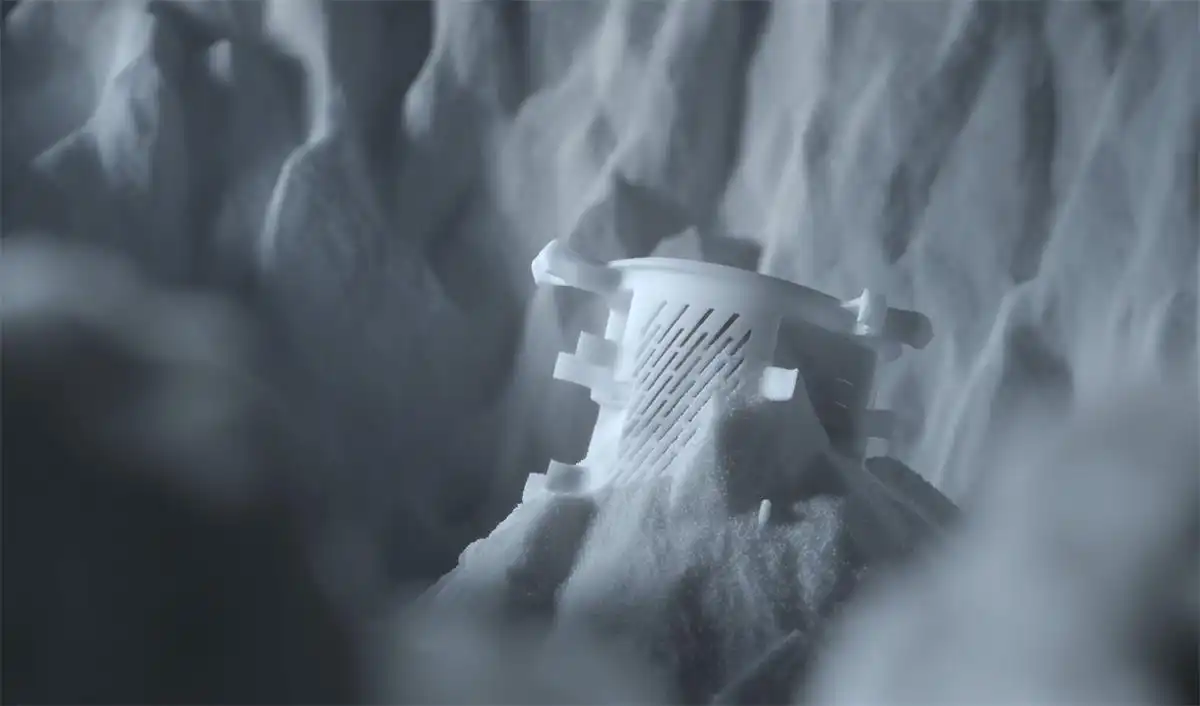
One of the major advantages of Selective Laser Sintering (SLS) is its versatility in materials. This flexibility allows for a wide range of applications, from prototyping to end-use parts. In this article, we’ll explore the various materials that can be used in SLS 3D printing, their properties, and their ideal applications.
Common Materials for SLS 3D Printing
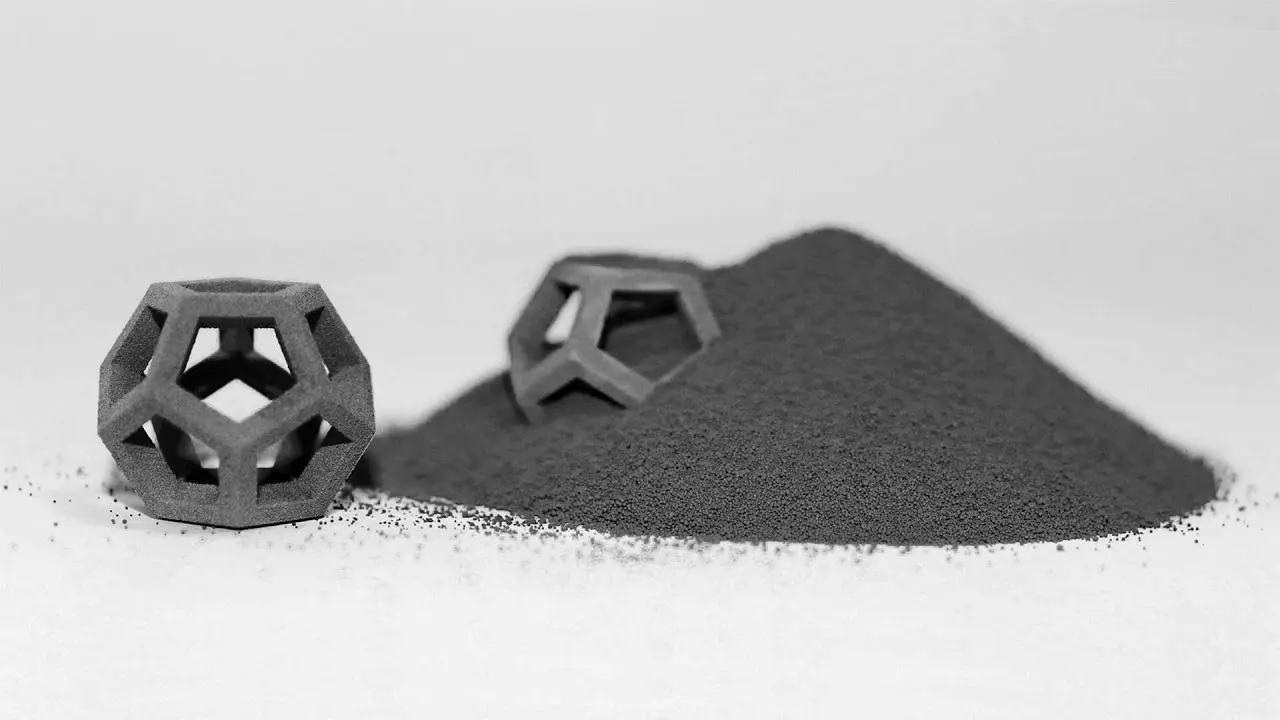
SLS technology is compatible with a variety of powdered materials, each offering unique characteristics. Here are some of the most commonly used materials:
- Nylon (Polyamide):
- Types: PA11, PA12, PA6
- Properties: High strength, flexibility, excellent chemical resistance.
- Applications: Functional prototypes, automotive parts, consumer goods.
- TPU (Thermoplastic Polyurethane):
- Properties: High elasticity, excellent abrasion resistance, good impact resistance.
- Applications: Flexible parts, gaskets, seals, footwear.
- Alumide:
- Composition: Nylon filled with aluminum powder.
- Properties: Metallic appearance, high stiffness, good thermal conductivity.
- Applications: Automotive parts, aerospace components, tooling.
- Glass-Filled Nylon:
- Composition: Nylon reinforced with glass fibers.
- Properties: Increased rigidity, higher thermal resistance.
- Applications: Structural components, parts requiring high stiffness.
- Carbon-Filled Nylon:
- Composition: Nylon reinforced with carbon fibers.
- Properties: High strength-to-weight ratio, improved impact resistance.
- Applications: Lightweight components, sports equipment, aerospace parts.
- Polypropylene (PP):
- Properties: Low density, good chemical resistance, excellent fatigue resistance.
- Applications: Automotive parts, living hinges, consumer goods.
Material Properties and Their Importance
Understanding the properties of these materials is crucial for selecting the right one for your project. Here’s a breakdown of some key properties to consider:
- Strength: The ability to withstand mechanical stress without deforming or breaking. Important for functional parts and load-bearing components.
- Flexibility: The material’s ability to bend without breaking. Essential for applications like gaskets, seals, and flexible prototypes.
- Chemical Resistance: The material’s resistance to chemicals, oils, and solvents. Critical for parts exposed to harsh environments.
- Thermal Resistance: The ability to withstand high temperatures. Important for applications like engine components and heat shields.
- Surface Finish: The quality of the surface after printing. A smoother finish often requires less post-processing.
Material Properties Overview
| Material | Strength | Flexibility | Chemical Resistance | Thermal Resistance | Surface Finish |
| Nylon (PA12) | High | Moderate | Excellent | Good | Rough |
| TPU | Moderate | High | Good | Moderate | Rough |
| Alumide | High | Low | Moderate | High | Rough |
| Glass-Filled Nylon | Very High | Low | Excellent | Very High | Rough |
| Carbon-Filled Nylon | Very High | Low | Good | High | Rough |
| Polypropylene (PP) | Moderate | High | Excellent | Moderate | Rough |
Choosing the Right Material
Selecting the right material for your SLS project depends on various factors, including the application, desired properties, and budget. Here are some guidelines to help you choose:
- Functional Prototypes:
- Best Materials: Nylon (PA12), Glass-Filled Nylon
- Reason: High strength and durability.
- Flexible Parts:
- Best Materials: TPU, Polypropylene (PP)
- Reason: High flexibility and impact resistance.
- High-Temperature Applications:
- Best Materials: Glass-Filled Nylon, Alumide
- Reason: Excellent thermal resistance.
- Lightweight Components:
- Best Materials: Carbon-Filled Nylon
- Reason: High strength-to-weight ratio.
- Complex Geometries:
- Best Materials: Nylon (PA12), TPU
- Reason: Good balance of strength, flexibility, and ease of printing.
The versatility of materials in SLS 3D printing makes it a powerful technology for a wide range of applications. By understanding the properties and ideal uses of each material, you can select the best option for your specific needs. Whether you’re looking to produce functional prototypes, flexible parts, or high-strength components, SLS offers a material solution to meet your requirements.
Exploring the various materials available for SLS 3D printing opens up a world of possibilities, allowing you to push the boundaries of design and functionality. With the right material, you can achieve outstanding results that meet and exceed your project’s goals.
Applications of SLS 3D Printing
Selective Laser Sintering (SLS) has revolutionized the way we approach manufacturing, prototyping, and product development. Its ability to produce high-quality, durable parts with complex geometries has opened the door to numerous applications across various industries. In this article, we’ll delve into the diverse applications of SLS 3D printing, showcasing how this technology is utilized to solve real-world challenges and innovate new solutions.
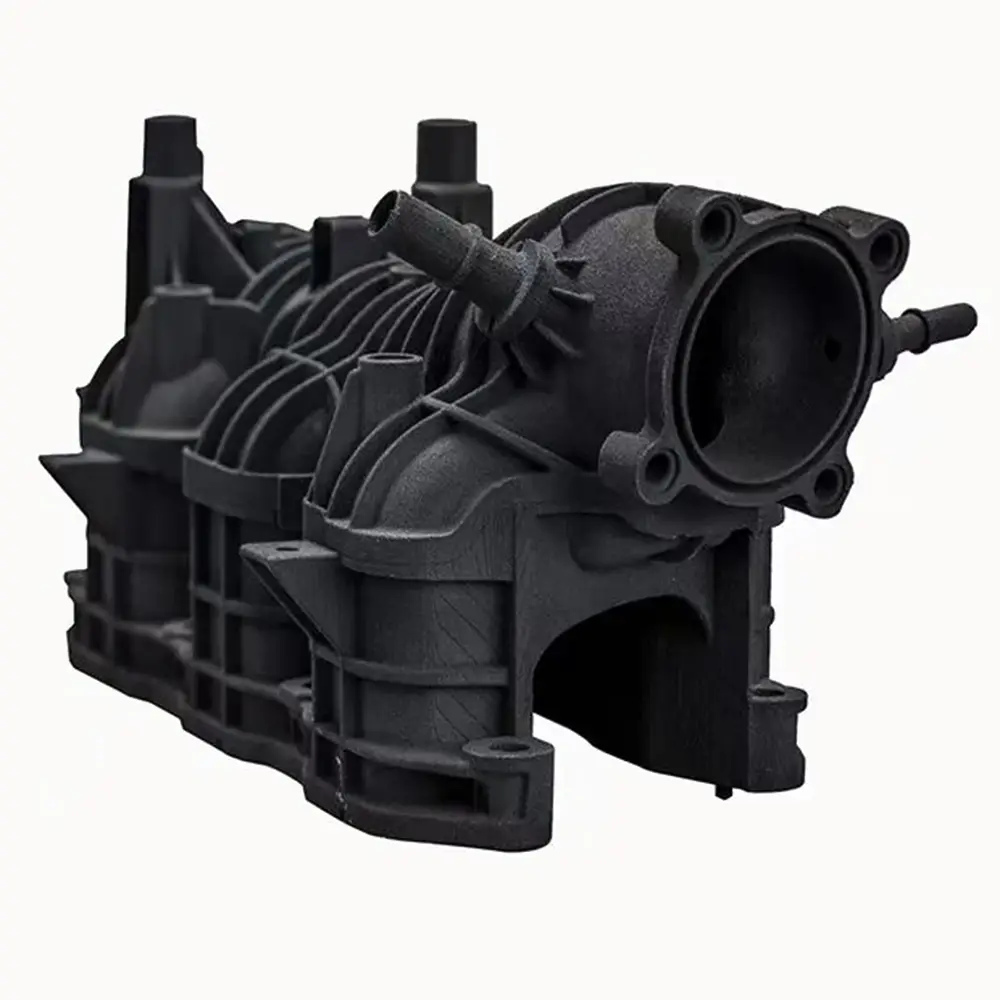
Industrial Applications
- Aerospace and Defense:
- Lightweight Components: SLS is used to produce lightweight yet strong components, such as brackets, housings, and ducting systems. This reduces fuel consumption and enhances aircraft performance.
- Custom Tooling: The aerospace industry benefits from SLS for creating custom tools, jigs, and fixtures that are tailored to specific tasks, improving efficiency and precision.
- Spare Parts Production: SLS allows for on-demand production of spare parts, reducing inventory costs and lead times.
- Automotive:
- Prototyping: SLS is widely used for rapid prototyping of automotive parts. Engineers can quickly iterate and test designs, leading to faster development cycles.
- Custom and Low-Volume Parts: SLS enables the production of custom and low-volume parts, such as interior components, brackets, and connectors, without the need for expensive tooling.
- Functional Testing: The high strength and durability of SLS parts make them ideal for functional testing under real-world conditions.
- Medical and Healthcare:
- Medical Devices: SLS is used to create custom medical devices, such as surgical guides, orthotics, and prosthetics, tailored to individual patient needs.
- Anatomical Models: Detailed anatomical models produced with SLS help surgeons plan and practice complex procedures, improving surgical outcomes.
- Implants: Biocompatible materials used in SLS allow for the production of custom implants that match the patient’s anatomy.
Consumer and Lifestyle Applications
- Consumer Electronics:
- Custom Enclosures: SLS is used to produce custom enclosures and housings for electronic devices, offering flexibility in design and material choice.
- Prototyping and Testing: Rapid prototyping with SLS allows for quick testing and iteration of electronic components, leading to faster product development.
- Fashion and Footwear:
- Customized Footwear: SLS enables the production of customized footwear, including insoles and outsoles tailored to individual foot shapes and biomechanics.
- Fashion Accessories: Designers use SLS to create intricate fashion accessories, such as jewelry, eyewear, and wearable tech, that would be difficult to manufacture using traditional methods.
- Sports Equipment:
- Custom Gear: Athletes benefit from custom sports gear, such as helmets, pads, and protective equipment, designed to their specific needs and preferences.
- Performance Enhancement: SLS allows for the optimization of sports equipment, improving performance, reducing weight, and enhancing durability.
Engineering and Manufacturing Applications
- Tooling and Jigs:
- Custom Tools: SLS is ideal for creating custom tools and jigs that improve manufacturing processes, reduce setup times, and enhance precision.
- Rapid Tooling: Tooling produced with SLS can be quickly iterated and adapted to changing production needs, providing flexibility in manufacturing.
- Functional Prototypes:
- Testing and Validation: Engineers use SLS to produce functional prototypes that can be tested under real-world conditions, ensuring that designs meet performance and durability requirements.
- Iterative Design: The rapid prototyping capabilities of SLS allow for quick iteration and refinement of designs, reducing development time.
- End-Use Parts:
- Low-Volume Production: SLS is cost-effective for low-volume production runs, making it suitable for custom or niche products that do not require mass production.
- Complex Geometries: The ability to produce parts with complex geometries and internal structures without the need for support material makes SLS ideal for intricate designs.
Applications by Industry
| Industry | Applications | Benefits |
| Aerospace | Lightweight components, custom tooling, spare parts | Reduced weight, improved efficiency, cost savings |
| Automotive | Prototyping, custom parts, functional testing | Faster development, customization, durability |
| Medical | Medical devices, anatomical models, implants | Customization, improved surgical outcomes, biocompatibility |
| Consumer Electronics | Custom enclosures, prototyping | Design flexibility, rapid iteration |
| Fashion & Footwear | Customized footwear, fashion accessories | Personalization, intricate designs |
| Sports Equipment | Custom gear, performance enhancement | Optimization, improved performance |
| Manufacturing | Tooling, functional prototypes, end-use parts | Flexibility, precision, cost-effective low-volume production |
SLS 3D printing has established itself as a versatile and powerful technology, capable of addressing a wide range of applications across various industries. From aerospace and automotive to medical and consumer goods, SLS enables the creation of high-quality, durable parts with complex geometries and tailored properties. By leveraging the unique advantages of SLS, businesses can innovate, optimize, and bring new products to market faster and more efficiently.
Whether you’re looking to improve manufacturing processes, develop custom solutions, or explore new design possibilities, SLS 3D printing offers a robust and flexible platform to meet your needs. The future of manufacturing is here, and SLS is leading the charge.
Post-Processing in SLS 3D Printing
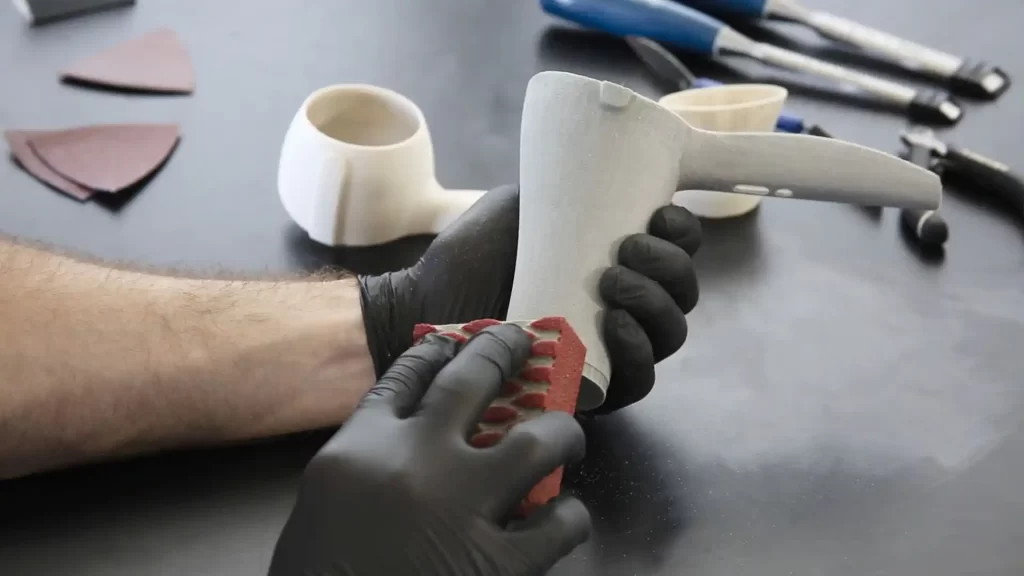
Selective Laser Sintering (SLS) 3D printing is renowned for producing high-quality parts with complex geometries, but achieving the desired finish and functionality often requires additional post-processing steps. These steps can enhance the mechanical properties, appearance, and usability of the printed parts. In this article, we’ll explore the various post-processing techniques used in SLS 3D printing, their purposes, and how they can be applied to achieve optimal results.
Common Post-Processing Techniques
- Depowdering:
- Purpose: Remove excess powder that remains on the part after the printing process.
- Methods:
- Manual Brushing: Using brushes to manually remove loose powder.
- Compressed Air: Blowing away powder with compressed air for a more thorough clean.
- Vacuuming: Using a vacuum system to collect and remove powder.
- Considerations: Ensuring all powder is removed is crucial for achieving a clean surface and avoiding contamination in subsequent processes.
- Surface Finishing:
- Purpose: Improve the surface quality and appearance of the printed parts.
- Methods:
- Sanding: Manually or mechanically sanding the surface to smooth rough areas.
- Media Blasting: Using abrasive media to uniformly smooth the surface.
- Chemical Smoothing: Applying chemicals to dissolve and smooth the outer layer of the part.
- Considerations: Surface finishing can affect the part’s dimensions and should be done carefully to maintain tolerances.
- Dyeing and Coloring:
- Purpose: Add color to the parts for aesthetic or functional purposes.
- Methods:
- Dyeing: Submerging parts in dye solutions to achieve uniform coloring.
- Painting: Applying paint to the surface for specific color and finish requirements.
- Considerations: Dyeing is typically more uniform and less likely to affect surface details compared to painting.
- Infiltration:
- Purpose: Enhance mechanical properties and surface finish by filling pores.
- Methods:
- Resin Infiltration: Applying resin to the part to fill in microscopic pores and improve strength.
- Wax Infiltration: Using wax to fill pores, often used for improving surface finish.
- Considerations: Infiltration can increase the weight and alter the feel of the part, so it should be chosen based on the application needs.
- Heat Treatment:
- Purpose: Improve mechanical properties such as strength and thermal resistance.
- Methods:
- Annealing: Heating the part to a specific temperature and then slowly cooling it to relieve internal stresses.
- Sintering: Further sintering the part to enhance its structural integrity.
- Considerations: Heat treatment should be carefully controlled to avoid warping or altering the part’s dimensions.
Post-Processing Techniques Overview
| Technique | Purpose | Methods | Considerations |
| Depowdering | Remove excess powder | Manual brushing, compressed air, vacuum | Thorough removal is crucial |
| Surface Finishing | Improve surface quality | Sanding, media blasting, chemical smoothing | Can affect dimensions |
| Dyeing and Coloring | Add color | Dyeing, painting | Dyeing is more uniform |
| Infiltration | Enhance properties, surface finish | Resin infiltration, wax infiltration | Can increase weight, alter feel |
| Heat Treatment | Improve mechanical properties | Annealing, sintering | Careful control to avoid warping |
Specialized Post-Processing Methods
- Electroplating:
- Purpose: Add a metallic coating to the part for improved aesthetic and mechanical properties.
- Process: The part is coated with a conductive layer and then submerged in an electroplating solution where metal ions are deposited onto the surface.
- Applications: Used in automotive, aerospace, and consumer electronics for parts that require a metallic finish and enhanced durability.
- Machining:
- Purpose: Achieve high precision and fine details that are not possible with 3D printing alone.
- Process: CNC machining or other subtractive techniques are used to refine the part’s dimensions and features.
- Applications: Ideal for parts that require tight tolerances and high precision, such as mechanical components and custom tools.
- Ultrasonic Cleaning:
- Purpose: Remove fine powder residues and contaminants from complex geometries.
- Process: Parts are submerged in a cleaning solution and subjected to ultrasonic waves, which agitate the solution and dislodge particles.
- Applications: Used in medical and aerospace industries where cleanliness and precision are critical.
Benefits of Post-Processing
Post-processing offers several benefits that can significantly enhance the performance and appearance of SLS-printed parts:
- Improved Surface Finish: Techniques like sanding and media blasting can create smoother surfaces, improving the part’s aesthetic and tactile qualities.
- Enhanced Mechanical Properties: Infiltration and heat treatment can increase strength, durability, and thermal resistance.
- Custom Aesthetics: Dyeing, painting, and electroplating allow for customized colors and finishes that meet specific design requirements.
- Precision and Accuracy: Machining and other precision techniques ensure parts meet exact specifications and tolerances.
- Functional Optimization: Post-processing can tailor parts to their intended applications, enhancing functionality and performance.
Post-processing is a vital step in the SLS 3D printing workflow, transforming raw printed parts into refined, functional, and visually appealing products. By understanding and utilizing the various post-processing techniques, you can unlock the full potential of SLS 3D printing, ensuring that your parts meet the highest standards of quality and performance.
Whether you’re aiming to improve surface finish, enhance mechanical properties, or customize aesthetics, the right post-processing methods can make all the difference. With careful planning and execution, post-processing can elevate your SLS 3D printed parts to new levels of excellence, ready to meet the demands of any application.
Future Trends in SLS 3D Printing
Selective Laser Sintering (SLS) has already made significant strides in transforming manufacturing and prototyping processes. However, the technology continues to evolve, promising even more exciting advancements in the near future. In this article, we’ll explore the future trends in SLS 3D printing, focusing on innovations that could shape the industry and expand its applications.
Advances in Materials
- High-Performance Polymers:
- Trend: Development of new high-performance polymers that offer superior mechanical properties, thermal stability, and chemical resistance.
- Impact: These advanced materials will enable SLS to be used in more demanding applications, such as aerospace, automotive, and medical industries.
- Examples: PEEK (Polyether Ether Ketone), PEKK (Polyetherketoneketone), and other high-temperature thermoplastics.
- Composite Materials:
- Trend: Increasing use of composite materials that combine the properties of polymers with reinforcing agents like carbon fibers, glass fibers, and metals.
- Impact: Enhanced strength, stiffness, and lightweight properties will make SLS parts suitable for high-performance and structural applications.
- Examples: Carbon-fiber reinforced nylon, glass-filled polyamide.
- Biodegradable and Biocompatible Materials:
- Trend: Development of biodegradable materials for environmentally friendly applications and biocompatible materials for medical use.
- Impact: Expansion of SLS into sustainable manufacturing and personalized healthcare solutions.
- Examples: PLA (Polylactic Acid), bio-based nylons.
Technological Innovations
- Multi-Material Printing:
- Trend: Advances in SLS technology that enable the simultaneous printing of multiple materials in a single build.
- Impact: Greater design flexibility and the ability to create parts with varying properties within a single print, such as hard and soft sections.
- Examples: Multi-material SLS printers capable of processing different powders in one layer.
- Increased Printing Speed:
- Trend: Continuous improvements in laser technology and scanning systems to increase the printing speed of SLS machines.
- Impact: Reduced production times, making SLS more competitive with traditional manufacturing methods for high-volume production.
- Examples: High-speed lasers, advanced scanning algorithms.
- Enhanced Automation:
- Trend: Integration of automation technologies for pre-processing, post-processing, and part handling.
- Impact: Streamlined workflows, reduced labor costs, and increased consistency and reliability in production.
- Examples: Automated powder handling systems, robotic depowdering solutions.
Industry Applications
- Mass Customization:
- Trend: Leveraging SLS for mass customization of products tailored to individual customer specifications.
- Impact: Expansion of personalized consumer goods, medical devices, and industrial components.
- Examples: Custom-fit orthotics, personalized eyewear, bespoke automotive interior parts.
- On-Demand Manufacturing:
- Trend: Adoption of SLS for on-demand manufacturing, reducing the need for inventory and enabling just-in-time production.
- Impact: Cost savings, reduced waste, and greater responsiveness to market demands.
- Examples: Spare parts production, rapid tooling, and prototyping services.
- Distributed Manufacturing:
- Trend: Decentralization of manufacturing with SLS, allowing production to be localized closer to end-users.
- Impact: Shortened supply chains, reduced shipping costs, and increased flexibility in manufacturing.
- Examples: Localized production hubs, networked 3D printing facilities.
Sustainability and Environmental Impact
- Recyclable Materials:
- Trend: Development and use of recyclable materials that can be reused in the SLS process.
- Impact: Reduction in material waste and lower environmental footprint of SLS 3D printing.
- Examples: Recyclable nylon powders, closed-loop recycling systems.
- Energy Efficiency:
- Trend: Innovations aimed at reducing the energy consumption of SLS machines.
- Impact: Lower operating costs and reduced environmental impact.
- Examples: Energy-efficient lasers, optimized heating systems.
- Eco-Friendly Practices:
- Trend: Adoption of eco-friendly practices throughout the SLS production lifecycle.
- Impact: Improved sustainability and compliance with environmental regulations.
- Examples: Sustainable sourcing of raw materials, waste minimization strategies.
Future Trends in SLS 3D Printing
| Trend | Description | Impact | Examples |
| High-Performance Polymers | Development of advanced polymers | Expanded applications in demanding industries | PEEK, PEKK |
| Composite Materials | Use of reinforced polymers | Enhanced strength and lightweight properties | Carbon-fiber reinforced nylon |
| Biodegradable Materials | Development of eco-friendly materials | Sustainable manufacturing | PLA, bio-based nylons |
| Multi-Material Printing | Simultaneous printing of multiple materials | Greater design flexibility | Multi-material SLS printers |
| Increased Printing Speed | Faster laser and scanning technologies | Reduced production times | High-speed lasers |
| Enhanced Automation | Integration of automation technologies | Streamlined workflows, reduced labor costs | Automated powder handling systems |
| Mass Customization | Personalized products tailored to customers | Expansion of customized goods | Custom-fit orthotics, personalized eyewear |
| On-Demand Manufacturing | Just-in-time production | Cost savings, reduced waste | Spare parts production |
| Distributed Manufacturing | Decentralized production | Shortened supply chains, reduced shipping costs | Localized production hubs |
| Recyclable Materials | Use of recyclable materials | Reduction in material waste | Recyclable nylon powders |
| Energy Efficiency | Reduced energy consumption | Lower operating costs, reduced environmental impact | Energy-efficient lasers, optimized heating systems |
| Eco-Friendly Practices | Adoption of sustainable practices | Improved sustainability | Sustainable sourcing of raw materials |
The future of SLS 3D printing is bright, with numerous advancements on the horizon that promise to enhance its capabilities and broaden its applications. From high-performance materials and multi-material printing to increased automation and sustainable practices, the ongoing innovations in SLS technology are set to revolutionize the way we approach manufacturing.
By staying abreast of these trends and incorporating the latest advancements into their processes, businesses can leverage SLS 3D printing to achieve greater efficiency, customization, and sustainability. As SLS continues to evolve, it will undoubtedly play a pivotal role in shaping the future of manufacturing, enabling new possibilities and driving innovation across industries.


